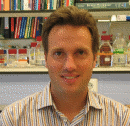The project
Regulation of the epithelial calcium channel by extracellular calciotropic factors.
Winner

Dr Joost Hoenderop
Physiology, section Cell Physiology (286)
Nijmegen Centre for Molecular Life Sciences
Radboud University Nijmegen Medical Centre
Geert Grooteplein Zuid 28
6500 HB Nijmegen
The Netherlands
http://www.physiology-nijmegen.nl
Joost Hoenderop, aged 36, is Assistant Professor of Physiology at the Nijmegen Centre for Molecular Life Sciences at the Radboud University Nijmegen Medical Centre in the Netherlands, specialising in the link between health and calcium balance in the body. He has published and lectured frequently on the regulation of epithelial calcium channels and is a reviewer on the subject for leading journals, including both the European and American Journals of Physiology. After his PhD in 2000, he was appointed as a postdoctoral EMBO fellow at Lausanne University in Switzerland in 2000 before joining his present post in 2001.
He said: “This is wonderful news as it guarantees the future of this project and means we will have all the resources, both in terms of people and equipment, that we need to build on our early success in identifying the key epithelial calcium channel”.
Provisional Award
€ 1,250,000
Project Description
Concentrations of calcium must be kept within tight constraints to maintain normal physiological function. The kidney plays a critical role in the absorption of calcium back into the blood from the glomerular* filtrate. The aim of this project is to unravel the molecular mechanisms by which extracellular calciotropic (calcium regulating) factors control the activity of the epithelial calcium channel (TRPV5) involved in hormonal control of calcium flux between the urine space and the blood. This function is essential in keeping calcium levels within a healthy range.
The project will build on two important discoveries made recently by Hoenderop to complete the picture of calcium homeostasis. First, he identified the TRPV5 epithelial calcium channel. Second, his recent studies unveiled a novel method of regulation in which the extracellular exposed N-glycan and amino acids of TRPV5 are essential players in channel activity regulation.
Several complementary areas of research including proteomics, electro-physiology, biochemistry, glycobiology, and human genetics, will be integrated to facilitate a comprehensive study from regulation of TRPV5 by urinary calciotropic factors in vivo to functional implications for the calcium homeostasis.
The innovative aspect of the project will be the elucidation of molecular pathways involved in the multifactorial pathogenesis of a disturbed calcium balance. This will in turn provide insights into the unsolved problem of the molecular mechanism of ageing, given that elderly people often have a disturbed calcium balance. This could lead to new therapies designed to modify the extracellular membrane involved in calcium-related disorders such as hypercalciuria. The project should also help maintain momentum in a field where Hoenderops’ work has given Europe a lead with his TRPV5 work.
*Glomerular – the kidney function of filtering the blood to form urine.

